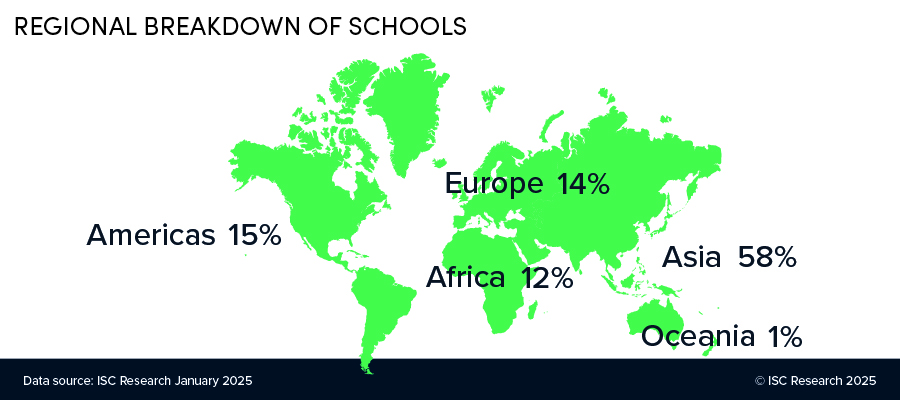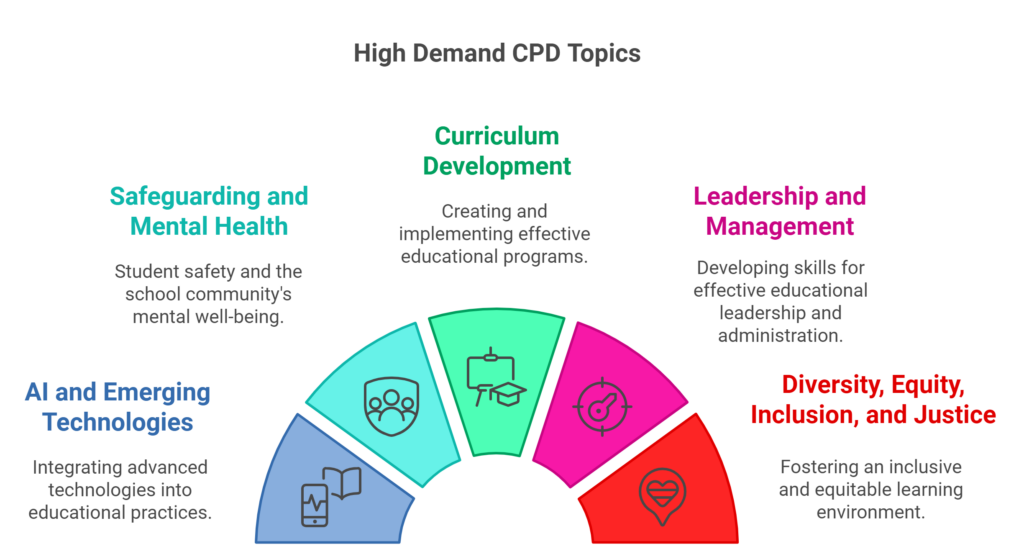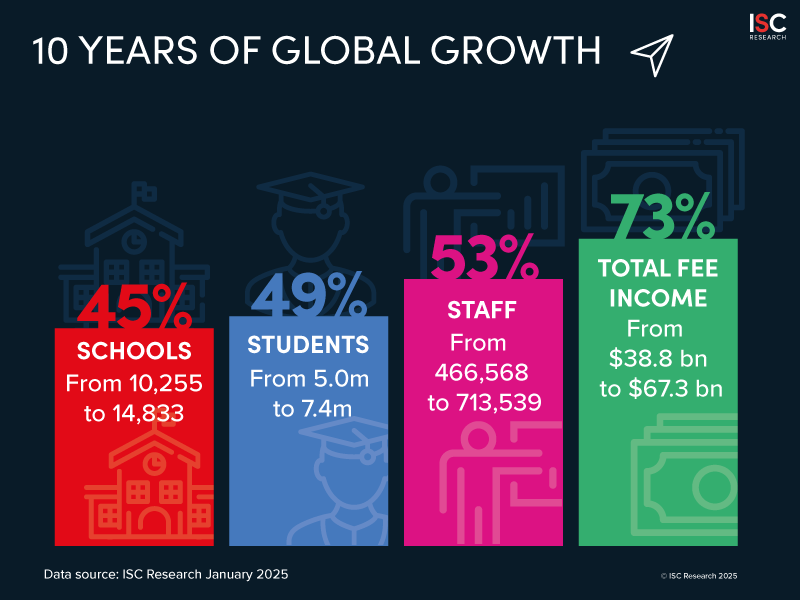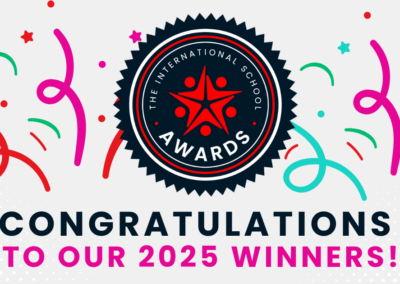With families around the world prioritising innovative, high-quality education that fosters both academic excellence and holistic development, international schools are at the forefront of emerging trends in global education. It is this ever-increasing recognition that is driving global demand for new schools, enrolment spaces, and staff members; the latest data on the international schools market shows continued rapid growth for January 2025.
Rising demand for international schools
ISC Research now records 14,833 K-12 international schools, with a significant 376 schools added to our database in the past six months alone. Asia continues to dominate the sector with 58% of the world’s schools based in the region. The rise of multinational corporations in countries like Japan, Malaysia, and South Korea is driving large expatriate communities who opt for the stability of international schools’ globally recognised curricula and English language instruction. Simultaneously, a growing regional economy and increasing numbers of mid-market fee schools are facilitating wider access to international education for local families.

The two countries with the most international schools are China and India, though there is an important distinction between the drivers behind their leading numbers. India’s expansion to 972 schools, with an additional 26 schools planned to open in the coming years, largely stems from supportive government policies that encourage partnerships with the UK and US to enhance education quality and ensure mutual qualification recognition.
By contrast, China’s 1,124 international schools see strict education regulations, yet 8 new school are still set to open, including the planned expansions of prominent brands such as Shrewsbury International School and EtonHouse. This reflects the sustained demand from Chinese families who consider bilingual Mandarin-English education essential university preparation, highlighting the importance of adapting to local needs within international school frameworks.
Shifting student demographics
The world’s international schools are serving a total of 7.4 million students worldwide, with demographics rapidly changing due to growing interest from local families. Local students now constitute significant parts of student bodies, and in some cases outnumber their international, expatriate peers.
This is prompting international schools to offer a more comprehensive multicultural education to cater to the diversity of their students, such that 36% of schools now offer bilingual or multilingual learning pathways. For instance, international schools operating in autonomous communities in Spain with co-official languages – e.g. Catalan – must teach both Spanish and the regional language as compulsory subjects, alongside developing students’ proficiency in English. Furthermore, international schools in Singapore are being favoured for expanding their programmes to include French instruction, in addition to offering additional English language support to non-native speakers.
36% of international schools now offer bilingual or multilingual learning pathways.
By offering tuition in more than one global language, whilst allowing local students to maintain their native language, international schools are becoming increasingly renowned for their ability to prepare students for higher education institutions around the world and, beyond that, for global workplaces.
Meeting the demands of a growing sector
International schools now employ 713,539 staff members globally, yet UNESCO reports a significant teacher shortage as the world approaches 2030; the fast-changing international school landscape presents challenges in attracting and retaining top teaching talent.
As per ISC Research’s Teacher Movement Survey, teachers choose the international education sector predominantly for travel and cultural exploration opportunities, for a new challenge, and for competitive salaries. However, most international schools can only expect to retain teachers for 1-6 years, with nearly half of survey participants stating that they plan to move on from their current job within this timeframe. Notably, these respondents cited “improved career prospects elsewhere” as the primary motivator behind their decision to leave, which comes in addition to “professional development opportunities” being chosen as one of the most important factors to teachers currently working the sector.
Schools are continuing to expand and adopt innovative educational models and technologies, and this is placing new demands on educators. As a result, Continued Professional Development has become essential for staff retention as teachers seek opportunities to attain new skills. With a growing multilingual student community, schools are prioritising EAL-focused CPD for teachers; as AI becomes increasingly integral to school life, international schools need to support teachers with its seamless and ethical integration into classroom practices. Investments such as this are crucial for maintaining teacher satisfaction levels and, in turn, the quality of education delivered by the institution.

Source: ISC Research
The economic impact of international education
As of January 2025, the international school market generates $67.3 billion USD in total annual fee income, representing a substantial 22% increase since January 2020. To maintain this growth, schools need to ensure they deliver the high-quality educational experiences that justify the significant investments from families. Not only does this include the prioritisation of a work environment that attracts and retains the best educators, but also investments into emerging tools and services that enhance teaching, learning, and operational practices.
Through tailored partnerships, ISC Research facilitates the introduction of reputable suppliers to schools that are both willing and able to invest in enhancing their educational offerings. This collaboration ensures that schools have access to high quality resources, whilst suppliers can effectively serve the international education community. To explore this further, a variety of client case studies can be found on the ISC Research website.



